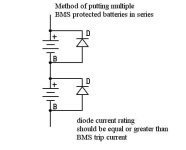Okay, we finally finished the testing, and everything seems pretty rock solid. I've built up two new boards, using the newest assembly and test instructions, and with a couple more tweaks, it will be ready-to-go.
Here is the final schematic:
Bob wrote up a very good "theory of operation", which also includes a more easily readable schematic. It can be found here
LiFeCycle BMS Description
One of the last changes we got in was Richard's suggestion about throttling back the charge current if any of the cells are too low (i.e. -- below 2.1V...). It turns out this simply required adding one more inexpensive NPN transistor.
We made a couple of changes to the layout, so I'm having another run done. I will have these back by Thursday. For the assembled and tested versions, we can use the existing boards, as it just requires a couple additions, mainly that make use of existing vias. The bottomline is we can probably make the assembled versions available starting tomorrow or Wendesday, and the kits by Friday. It will take about a week for the assembly and test for those versions
Here's what the PCB looks like:
It is pretty busy, mainly because we weren't ready to switch to surface mount, just yet, and because I wanted to keep this to the same 3" x 6" form factor, so that it will fit on front of a LiFeBatt pack.
Once I get the assembly and test procedures done we should be pretty much done. I still have some work to do on the heat sinks, but I'm hoping to finish up these tomorrow. These will be optional for the kits and the assembled versions, as there are lots of choices for these, depending on the installations.
Anyway, once we get these going, I will then also start offering LiFeBatt packs with integrated BMS units. I also just worked a deal with Soneil, so we will also be able to offer 36V and 48V versions of their excellent SRF series of chargers, with "tweaked" outputs to perfectly match the BMS.
-- Gary




